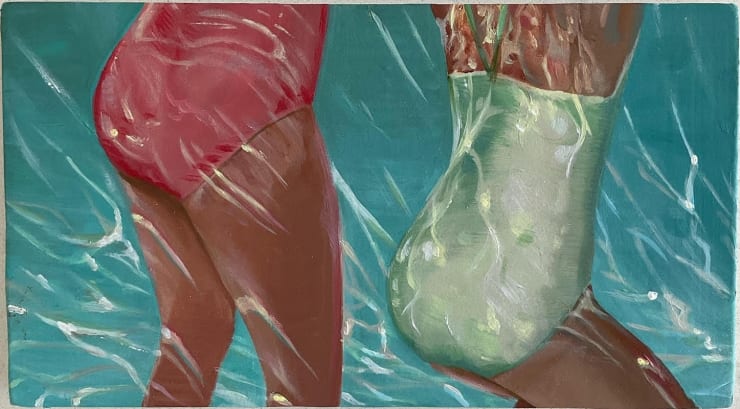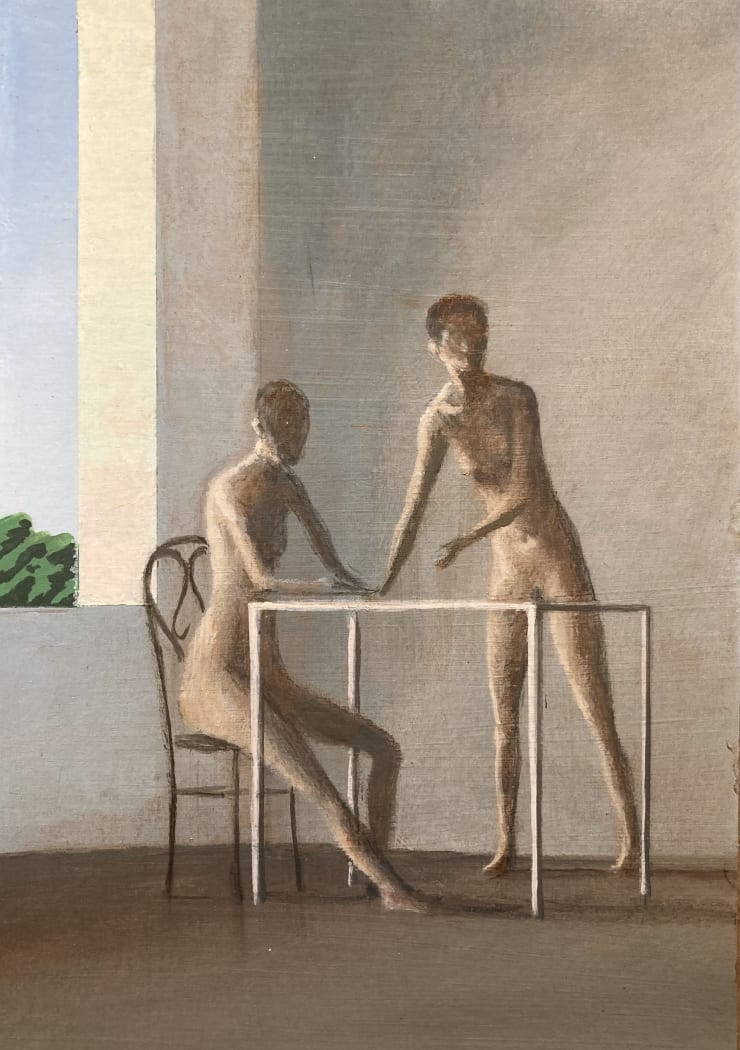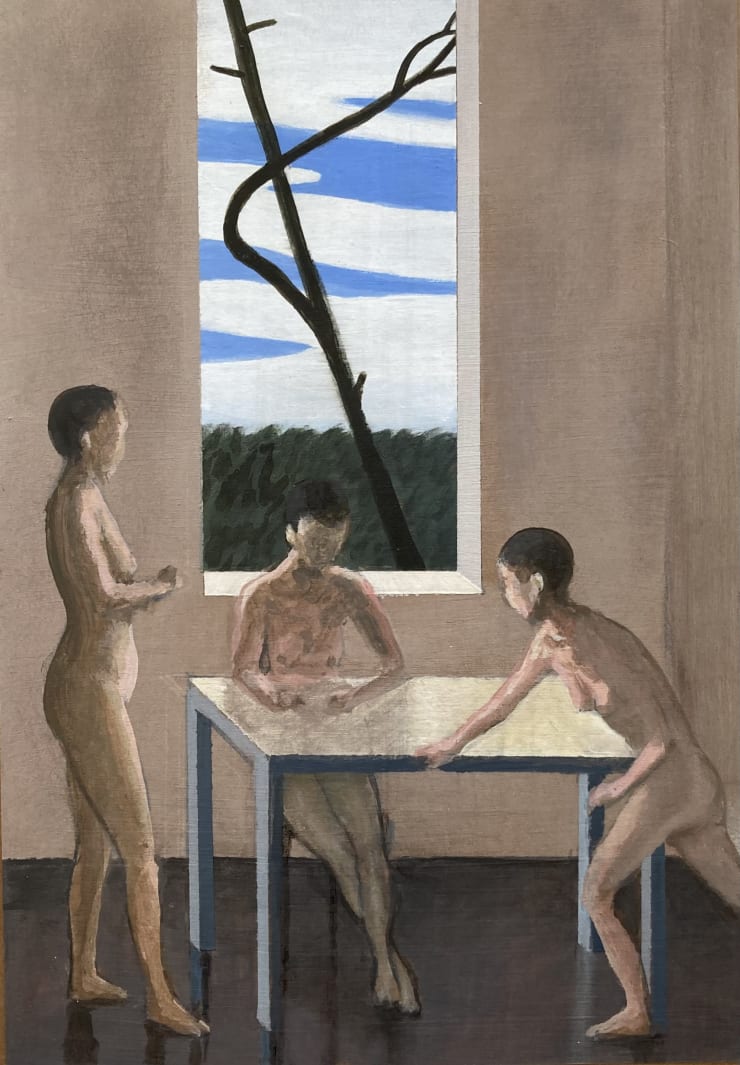Time: organized by Ryan Steadman
Press release
Pablo's Birthday is pleased to inaugurate 2023 with the group exhibition Time, organized by writer, curator, and artist Ryan Steadman, which showcases the work of Leonard Baby, Joan Boy, Helena Foster, Brandon Elijah Johnson, Sarah Pater, Emily Pettigrew, Giordanne Salley, and Arisa Yoshioka. Time features painters who use techniques, symbols, or imagery that infer a desire to stop, slow down, or reverse time through their paintings. Together, these works ask you to ponder and play with how we perceive the passing of time.
Leonard Baby’s (b. 1996, Colorado) work asserts ideas about solitude and melancholy via images taken from mid-century cinema, television, and advertising. His subjects are often film stills of popular culture, which he edits so as to engage with anonymity in various ways. The backs of figures or people with their heads cropped out of frame are Baby’s usual subjects, as they often allude to a fuller narrative percolating outside the painted area. As such, Baby’s work offers viewers a snapshot in time yet leaves room for imagination and self-reflection through a grander, unseen narrative.
Through painting, Joan Boy (b. 1961, Barcelona, Spain) expresses the overwhelming experience of waiting, contemplating or arriving at nothing through the endless cycle of time. His scenes provide comfort as much as they manifest fear of an eternal void. Joan's high-keyed color palette contrasts with a soft touch, giving his figures—like those painted by one of his heroes, Balthus—both a timeless quality and tangible humanity. His paintings tell a story about real, vulnerable people, but they have no beginning, middle, or end.
Helena Foster’s (b. 1988, Benin City, Nigeria) practice seeks to capture the day-to-day conflicts and complexities of most households via her own experiences. She often rephotographs pre-existing imagery and strips it down to an intimate moment between two figures or a single figure alone in contemplation. Foster’s paintings embrace themes of nostalgia, quiet emotion, or susceptibility, and she wields bold colors and breakneck-speed brushstrokes in a way which suggests there are forces around us that can easily slip in or out of our perceived reality.
Brandon Elijah Johnson (b. 1992, Seattle, WA) is interested in creating a world where the space between paintings is as important as any of his singular images. Using pictures he finds on the internet, Johnson reinterprets familiar scenes in his paintings in an attempt to freeze a perfect moment in time. His tightly-handled compositions draw from pop and underground cultures that have achieved some heroic or even timeless status. With these tried and true fictions, Johnson reflects parts of our collective memory back to us—in all their beauty and terrifying wonder.
The art of Sarah Pater (b. 1987, Wilmington, Delaware) overlays our everyday experiences with subtle yet radiant objects of the subconscious. As such, Pater’s paintings inhabit an almost universal time zone, absent a lodestar pointing toward reality. Snapshots of scenic views commingle with symbolic objects, merging what is inside with what is out. Her flattened yet carefully crafted compositions invite viewers to slow down their looking to a halt. In the end, Pater’s paintings offer familiar scenes rendered strange, blending the quotidian into the otherworldly in a land where all our time signifiers have been rendered moot.
By paring down the nonessential in her tightly-knit narrative paintings, Emily Pettigrew (b. 1991, Maine) grinds time down to a near halt. Her sparse paintings, usually depicting single figures or landscapes, could have captured a scene from 300 years ago as easily as a tableau from today. Her foundational principle, “the removal of excess parts… to an image’s most beautiful elements,” speaks to the idea of living forever through immaculate beauty. In this way, her works invite the viewer into a very focused and private arena where the compositional framing of anonymous figures within windows and doors offers viewers a sliver of a secret to eternity.
Giordanne Salley (b. 1986, Dayton, Ohio) paints themes based on love, loss, time, and duality. Her figures—or objects speaking to a human presence—get handsomely placed in a remembered or imagined landscape, usually in a liminal space or time, such as the edge of a body of water or near the end of a day. Infinite shadows and reflections signify alternate realities or hidden worlds. Meanwhile, the distortion and abstraction of her indirect imagery—usually reflected across or under gleaming waters—divulge a better world that lies beyond this one—one we almost but cannot quite grasp.
Arisa Yoshioka’s (b. Ulaanbaatar, Mongolia) work embodies a dreamlike slowness through a variety of strategies. Heavily detailed, her autobiographical figures, objects, and places in her paintings unfold before our eyes slowly, like an ancient fairy tale. The images almost seem to disintegrate within an endearing mix of delicate patterns and tangled brushwork, echoing the distressed tapestries of early Tibetan Thangka as much as the artist’s multitude of Western painting devices. Her scenes leave the viewer pondering between thoughts; what will happen and what has just happened. The dreamlike haze of her landscapes forces viewers to linger both in the past and present as they piece together the pregnant symbolism of her singular life.
-

Leonard Baby: Pool with Two Figures, 2023
-

Leonard Baby: Sing Your Own Special Song, 2023
-

Joan Boy: #1323A, 2022
-

Joan Boy: #1323B, 2022
-

Brandon Elijah Johnson: Summer Love, 2022
-

Brandon Elijah Johnson: Nocturne in blue, 2022
-

Helena Foster: FORESIGHT, 2022
-

Helena Foster: MOON INDUCING LABOUR, 2022
-

-

Sarah Pater: Gloaming (oyster and glass of water, relief), 2022
-

-

-

-

-

-



















